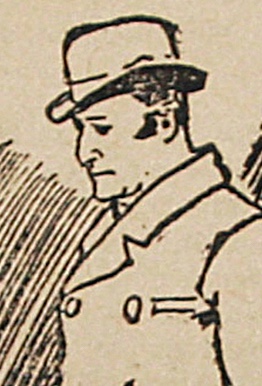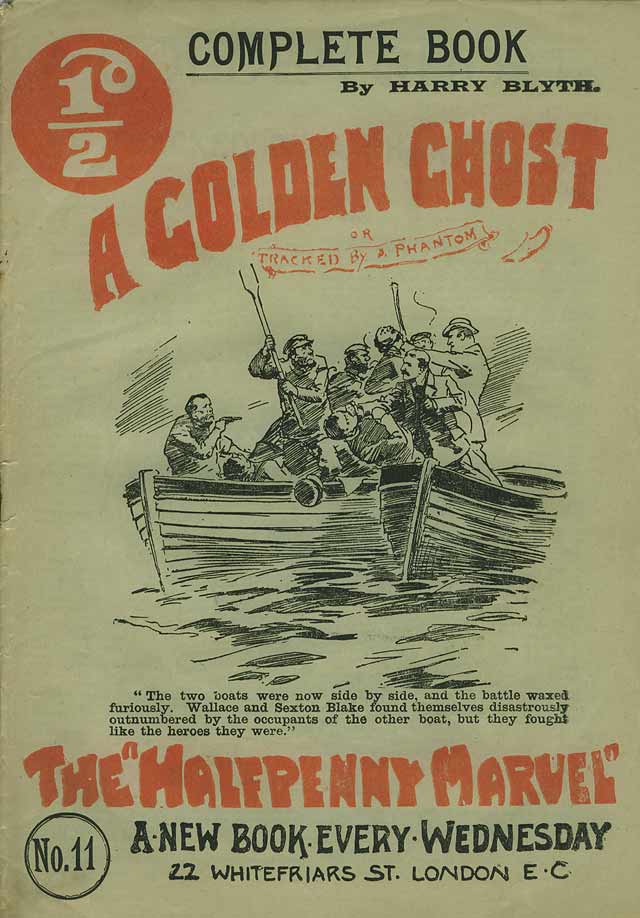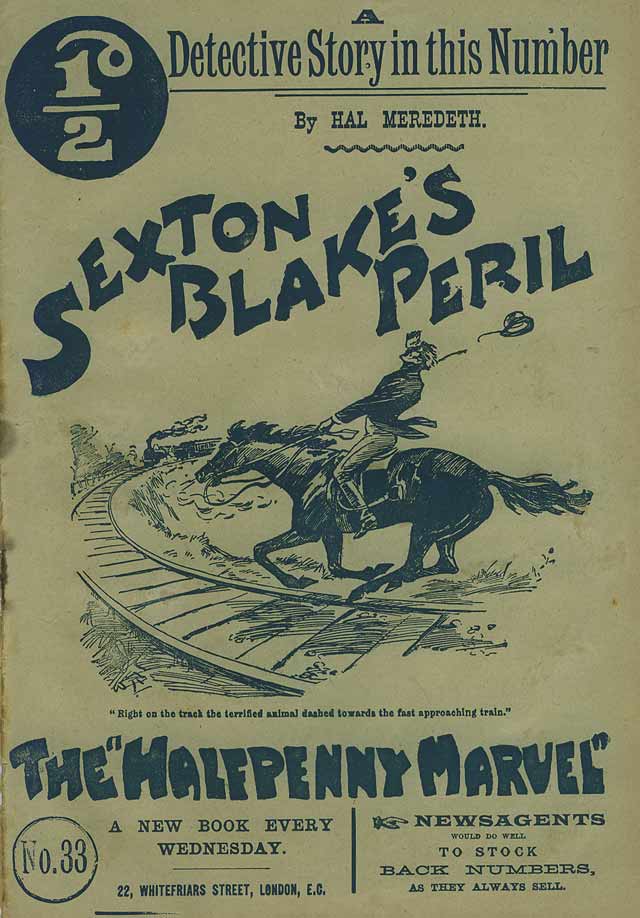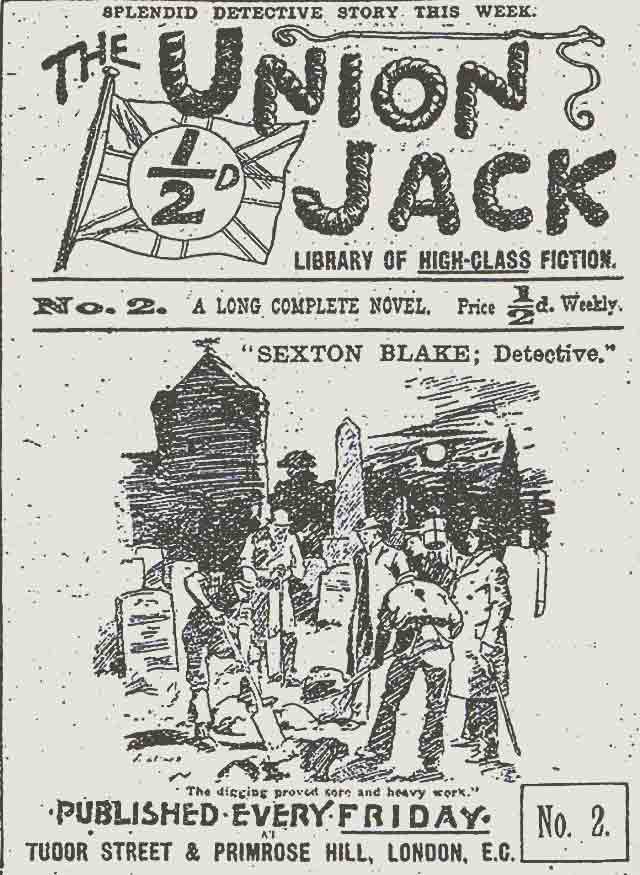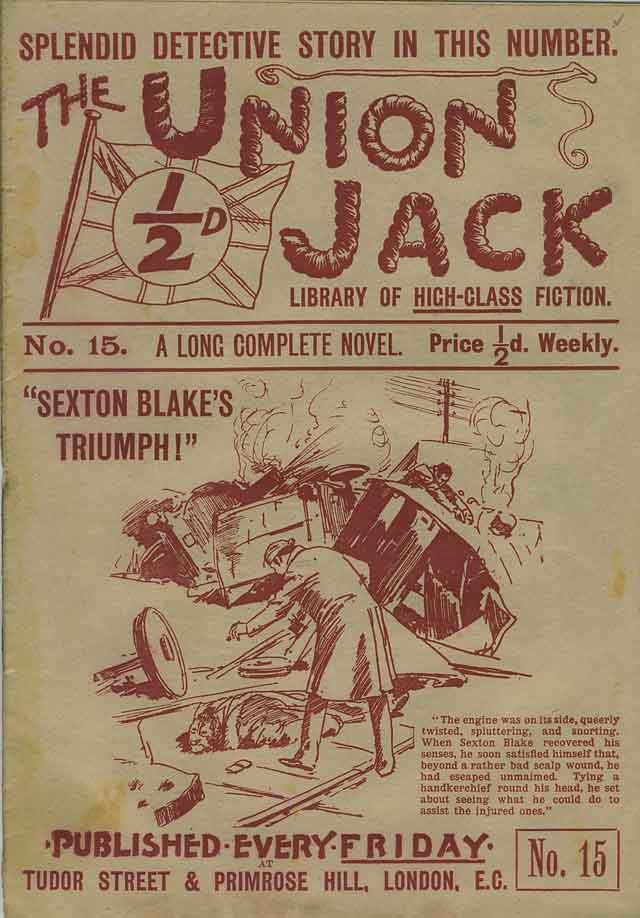Sexton Blake Bibliography: 1894
Publishing: Sexton Blake makes his first appearance in UNION JACK and the tradition that he is a real person begins. A non-Blake story entitled THE ACCUSING SHADOW, which appears in HALFPENNY MARVEL issue 48, features a solo mission by Jules Gervaise (and a passing reference to Blake).
Blake: Jules Gervaise retires and Blake begins to operate alone.
Author debut: William Geoffrey Bouchard de Montmerency, the Sixth Viscount Mountmorres (1872 - 1936) was an Irishman from County Galway. Early in his career as a freelance journalist he made contributions to ANSWERS. Of his serials, he is best known for this rambling 21-part Sexton Blake tale. He is known to have made just one other contribution to the saga, it being TRACKED AROUND THE WORLD (UNION JACK 1st series, issue 43), which was also published this year. Montmerency ended his days as Rector of Wokingham.
Notes: Sexton Blake, while resting at Swatley Cove, determines to elucidate the mystery of 'The Lamp of Death', the terror of all the fisher-folk along the coast. He is visited by Muriel Lane, who tells a sad story. Her father, who was in a fair way to make a fortune out of a new submarine boat, has been ruined by the theft of the plans. Blake promises to help Muriel. Only one man — Frederick Seale, a rejected suitor for her hand — knows the secret of her father's invention, and, with the idea of visiting this man's chalet at Dunkirk, Blake embarks for Calais on a vessel carrying bullion from the Bank of England. In mid-Channel, he sights the light from the Lamp of Death, and immediately afterwards there is a terrific explosion; the steamer is blown into a thousand pieces, and Blake finds himself, like his fellow-passengers, struggling in the water. A dreadful scene of carnage ensues. Several armed ruffians in a boat kill all those persons who have managed to keep themselves afloat. Blake alone escapes by clinging to the stern of their boat. The talk he overhears reveals to him that the Lamp of Death is an iron monster of the deep — a submarine boat used by a piratical crew to blow up vessels carrying bullion for foreign exchange. Towed to shore by the pirates' boat, the detective joins a British cruiser, one of the Channel Squadron, the captain of which resolves to give instant chase to the Black Barnacle, by which name the fiendish submarine freebooters call their vessel. The Lamp of Death is sighted, the Heptic's torpedoes are got in readiness, and a deadly battle seems imminent.
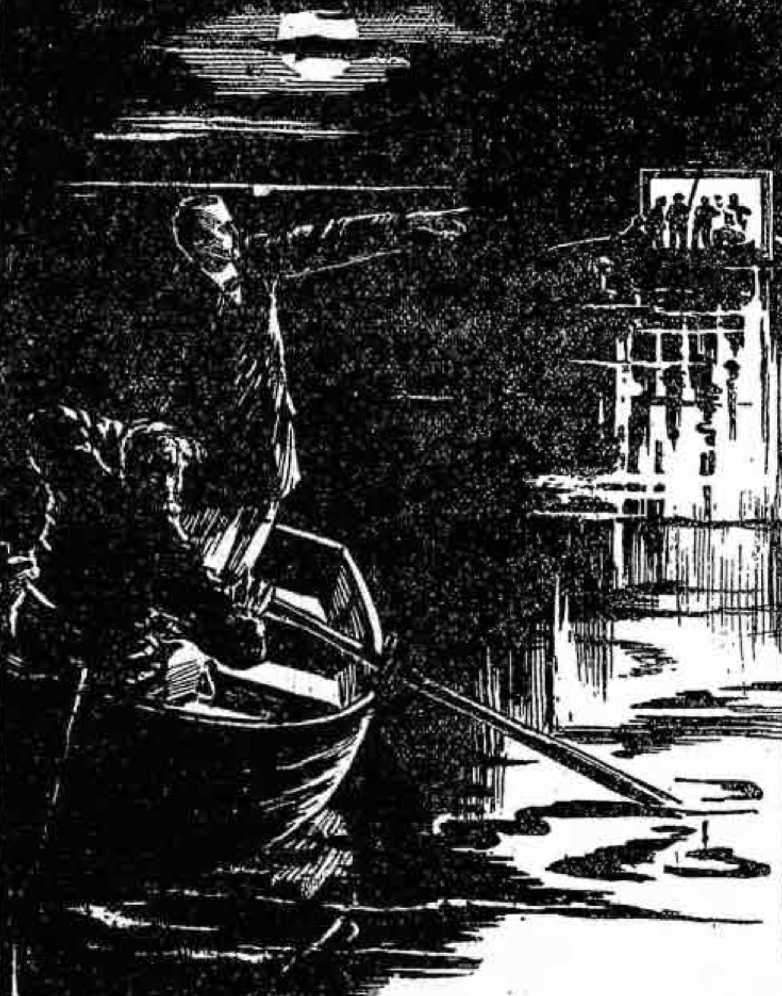
Trivia: Blake's solving of the 'Menpes Street Mystery' is mentioned ... this seems to be a reference to an actual story, though I haven't been able to trace it. The detective is strongly attracted to Muriel Lane in this first installment ... by the last, he's married to her! The unusually brutal scenes in this installment give a taste of what's to come ... this is one of the most bloodthirsty Sexton Blake stories ever written.
Rating: ★★★★☆
Notes: Beneath the English Channel, the Black Barnacle casts its grapnels amidst the wreckage of the cross-Channel steamer until it finds and draws into its iron belly the four chests of bullion. The submarine then surfaces to pick up the returning ruffians who had unwittingly towed Sexton Blake to the French shore. While boarding the vessel, one of the men slips into the sea and is mercilessly left to drown. The submarine resubmerges and Red-handed Pete, the spokeman for the villainous group — who are known as the 'Sea Wolves' — reports the detective's escape to Frederick Seale. Seale curses the carelessness of his crew but then tries to persuade them to do battle with the Heptic. They are a mutinous bunch and he has to shoot a man before they agree to engage with the man-o'-war.
Rating: ★★★★☆
Notes: Wallace Roy's uncle, Colonel Etheridge, arrives from India with members of a secret cult called the Zeefri hot on his tail. He has stolen a valuable gem, the Wharseeki, from one of their idols and has left it concealed in Siam. He intends for Wallace to recover it while he himself keeps the cultists occupied. Etheridge had been commissioned to find the jewel by Magnus Flute. The latter, a rich financier, has recently been robbed of valuable documents and employs Sexton Blake to retrieve them. The culprit was Bully George, who, though a villain, saves Wallace Roy's fiancee, Ada, from the attentions of a hunchback named Jasper Chipps. The Zeefri, led by Prince Nazley, lure Etheridge through means of a golden phantom to a secret den where they hold him captive. Meanwhile, Wallace Roy sets sail for the Far East. Bully George visits Magnus Flute and attempts to extort money from him in return for the stolen papers. These documents tell the story of Ada's father who, upon returning from a life in China, deposited £5,000 with Flute. Soon afterwards, he died without telling anyone about the money. Flute, who was in finacncial difficulties at the time, used it to bail himself out, thus denying Ada her rightful inheritance. As Bully attempts to use this information to bribe Flute, a hidden Sexton Blake listens. He then pounces and claps handcuffs onto the villain. As he is led away by the police, Bully escapes but is set upon in the street by Jasper Chipps and both fall under the wheels of a passing vehicle and are killed. Colonel Etheridge escapes from his prison after the building inexplicably collapses. Wallace Roy returns from Siam after a series of desperate adventures and hands the jewel to his uncle. On the day Wallace and Irma are wed, a large basket arrives for the Colonel from India. He opens it and a huge boa constrictor springs out and attacks him. He is saved by Sexton Blake and, for absolutely no reason, concludes that the Zeefri will never attack him again.
Trivia: The author loses his pen name for this issue. Blake seems very concerned about achieving some measure of fame: "I have fallen into a very nest of bloodthirsty criminals," he reflected; "and who can tell what remarkable revelation I may yet be able to astonish the world with?" There is no mention of Jules Gervaise.
Rating: ★★☆☆☆ Despite a contorted plot, pretty bad writing style and absurd (and totally unexplained) events, this is quite an entertaining story. But what was the phantom? Why did Etheridge's prison collapse? Why does he decide that he's safe from further attacks immediately after a snake nearly kills him? Harry Blyth's writing is so lacking in logic it often feels like a stream of consciousness. It should also be noted that this story owes a great deal to Wilkie Collins' THE MOONSTONE.
Notes: Against advice from his business partner Jules Gervaise, Blake takes on a case involving a gang of international criminals known as The Terrible Three. His trials include nearly being poisoned, nearly being gassed, being tied and locked in a coffin-sized box, being incarcerated and near-starved and drifting out into a stormy sea in an oar-less boat. Nevertheless, he wins through and defeats the gang.
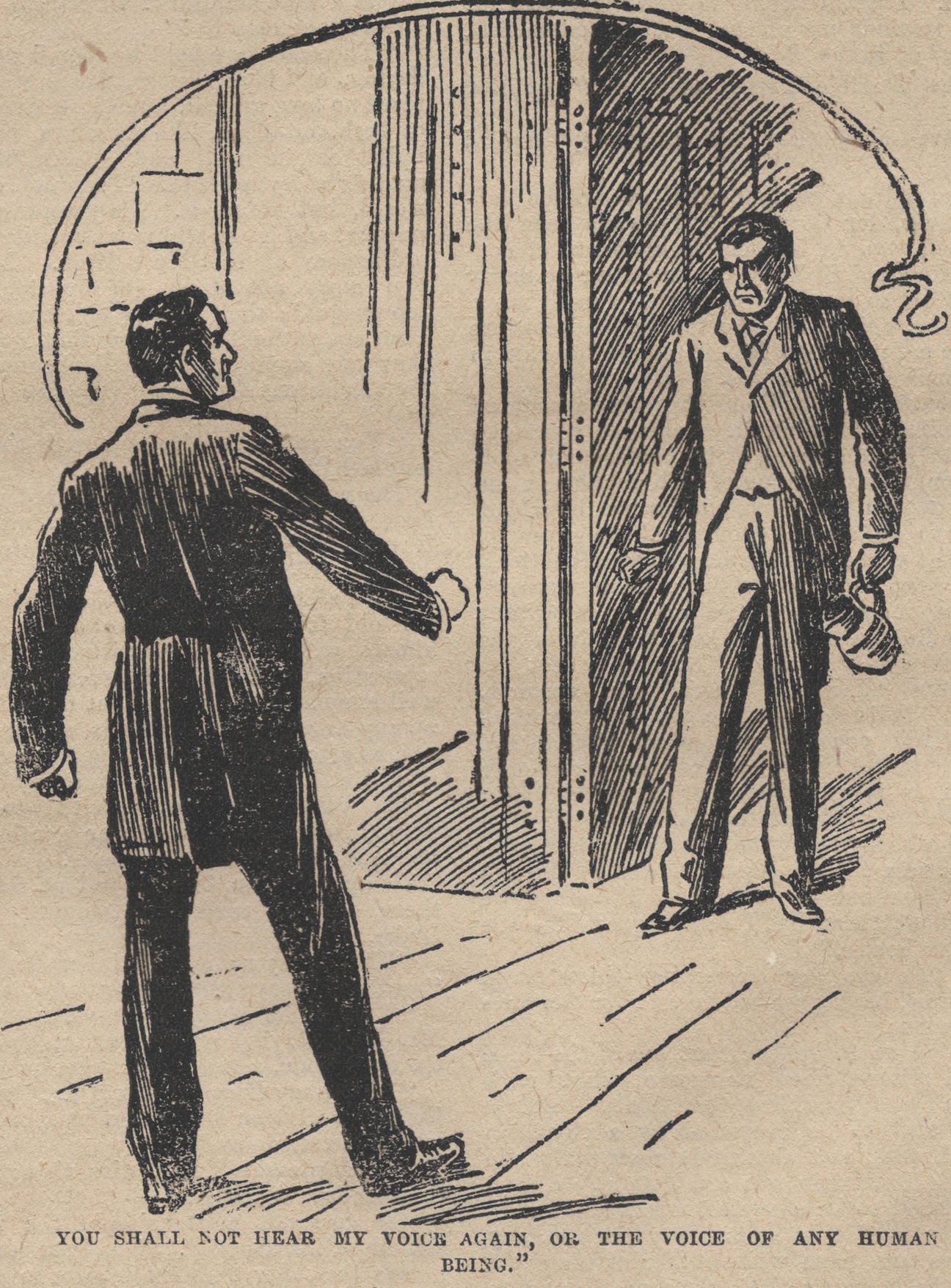
Trivia: In this story, Blake outlines a philosophy which holds true throughout his published lifetime: "We do not interfere in disputes between man and wife, nor do we pursue defaulting clerks. But if there is a wrong to be righted, an evil to be redressed, or a rescue of the weak and the suffering from the powerful, our hearty assistance can be readily obtained. We do nothing for hire here; we would cheerfully undertake to perform without fee or reward. But when our clients are wealthy we are not so unjust to ourselves as to make a gratuitous offer of our services."
Blake doesn't appear to be a particularly good detective at this stage of his career. In one scene jewels are stolen from nearly every guest at a party and he doesn't even notice. He even remains oblivious when the guests themselves start vanishing! In moments of unintentional humour, he seems more of an Inspector Clouseau than a Sherlock Holmes, such as in the priceless scene where he accidently falls through a ceiling into a room where a girl is being held prisoner: 'Sexton Blake, covered with lime and dust, sprang to his feet, with a cry -- "Lady Lena! Thank heaven! I have succeeded in finding you!".'
Jules Gervaise is presented as the more intelligent, if a little over-cautious, member of the detective duo — maybe because he's considerably older than Blake. In fact, Harry Blyth has Gervaise considering retirement in HALFPENNY MARVEL issue 48, in a non-Blakestory called THE ACCUSING SHADOW: "So it comes that now I say gladly, let my good partner, Sexton Blake, take the rewards and the honours, while I sit peacefully under my vine, and cultivate my garden." Gervaise, after this utterance, then embarks on another case, without Blake, and reflects at one point: "I am glad I have not Sexton Blake with me. He would inevitably ride a bicycle, plunge into a stream, or stop an engine in full career, before he got to the end of this business."
Rating: ★☆☆☆☆ Another garbled nonsensical Blyth plot! This is better than the two 1893 stories but not as entertaining as the previous issue's A GOLDEN GHOST.
Notes: When Harry Armytage returns home after two years at sea, he discovers that his uncle, Fenton Joyce, has died and the man's daughter, who is Harry's fiancee, has vanished. Harry consults Sexton Blake who discovers that Joyce's grave is empty. It seems that he isn't dead after all. Further investigations reveal that Joyce and his daughter are in the power of the villainous Gaspard Sellars. Blake exposes the criminal's scheme to extort money from Joyce, Sellars plunges to his death, and Harry and his fiancee are reunited.
Trivia: This is where the tradition of Sexton Blake being a real person begins. The Editor informs us that: "Some time ago we arranged with Mr. Sexton Blake, the celebrated detective, to furnish us with the particulars of the most remarkable and sensational cases he has been concerned in. From some of the materials he has placed at our disposal we have formed the following startling and authentic narrative, feeling sure that its strange details will excite a world-wide interest."
This issue is often mistakenly cited as the first ever appearance of Sexton Blake; a myth propagated in the 1,000th edition of UNION JACK wherein this issue's cover was reproduced and cited as the issue in which the detective was created. The tale was then reprinted (in an abridged form) as "The first Sexton Blake Story ever published" in the second SEXTON BLAKE ANNUAL (1940) and again in the VALIANT BOOK OF TV'S SEXTON BLAKE (1968). It was also reprinted in PENNY POPULAR issue 52 as THE HAUNTED MAN (1913).
Rating: ★☆☆☆☆ It's Sexton Blake's debut in the magazine that would make him famous ... and it's appallingly bad! Melodramatic in the extreme, this story feels like it was written in a great hurry. The plot makes no sense; things happen without explanation (for example, a tower explodes for no reason, prompting a character to think "I must have dropped a match.") and bizarre coincidences are a recurring plot device (in fact, the only plot device) ... in other words it's a typical Harry Blyth tale! There is, however, a great scene in which the villain falls in with a disguised Blake. The moment when the detective rips off his wig and reveals his true identity is classic.
Notes: Retiring artist Hector Hurlford receives an unexpected visit from his old schoolfriend, William Rennie. Though he has just arrived from Australia, William carries no luggage. After an enjoyable evening together, the two men repair to their rooms. In the morning, William has inexplicably vanished. The house remains locked up from the inside. There is no way he could have left without leaving evidence of his exit. Yet he is gone. Hurlford calls his friend Sexton Blake and tells him of William's history: Just under five years ago, after a dispute about the girl he married, William had left his family home and emigrated to Australia with his wife. The following night, his father was assaulted and the house robbed. The absent William was blamed for this crime. Before passing away, his father made a will, offering the bulk of his wealth to his son should William be able to prove his innocence within five years. If he could not, his sister Laura would inherit the estate instead. With the deadline looming and his wife now dead, William had returned to England to denounce the man he had learned was responsible for the crime. The next day, William's corpse is fished from the Thames. Blake sends Hurlford to the Rennie estate to contact Laura. The detective then discovers that an empty house two doors down from Hurlfords was owned by the elder Rennie and is currently being looked after by the family lawyer, Jabez Forge. He gains entry and discovers how William was transported over the rooftops from one house to the other. He also finds a villain known as The Slaughterer hiding in the house. The man makes his escape with Blake in hot pursuit (on a bicycle). Meanwhile Hurlford is accepted as a guest in the Rennie household and quickly falls for Laura. But she is engaged to Jabez Forge's son, Justin, and the two men soon share a mutual hatred of one another. The two Forge men plan to frame Hurlford for the robbery and assault of the now-deceased elder Rennie. Blake follows The Slaughterer onto a train and attempts to get information out of him about the of William Rennie. When the train crashes, The Slaughterer gets aways and Blake is astonished to find, among the survivors, a man purporting to be the self-same William. Back on at the estate, Hurlford witnesses The Slaughterer asking Justin Forge for payment for the assault and robbery he had carried out all those years ago. Forge tries to kill him but is caught red-handed by Blake and the real William Rennie. Confessions, explanations and justice swiftly follow.

Trivia: Harold Blyth's pen name is misspelled 'Meredith' rather than the usual 'Meredeth' in this issue. The second UNION JACK tale is, as with the first, presented "with the help and permission of the great detective himself."
Rating: ★★☆☆☆ This is one of Harry Blyth's better stories, though it ends rather abruptly and with too much convenient neatness.

